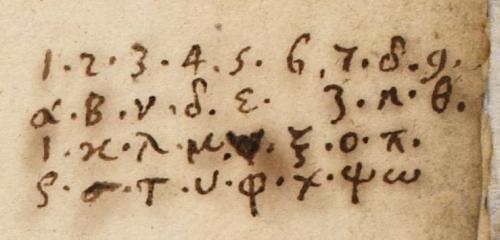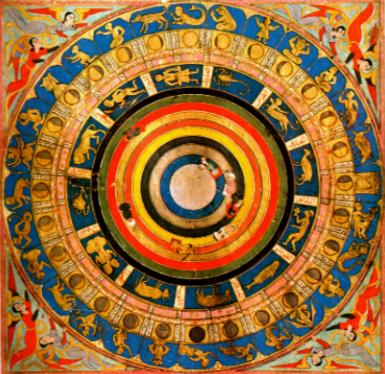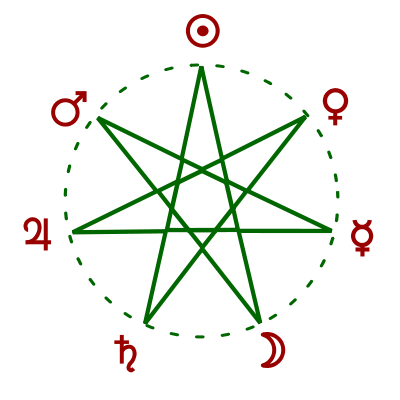
Correspondence Chart written in the margins of a page in The Treatise of Solomon. The first row of characters shows Arabic numerals. The second row, the first 8 letters of the Greek Alphabet, which are 1-9. The third row represents 10-80, and the fourth row represents 100-800. The characters for 6, 90, and 900 had fallen out of use by this time.
by J.A.Doyle, 2130
Before the invention and widespread utilization of a specialized system of written characters used to represent numerical values, the Ancients most often turned to their written alphabet to illustrate the complex relationship of numbers and the cosmos. Prior to this, however, the Ancients arranged tiny stones into patterns to function as their visual calculator. The Greek word for pebble was ‘psephos‘, and it also stood for “calculation” (calculi itself being the Latin word for ‘pebble’). Eventually, the Ancients needed a better way than pebbles to display the more complex of mathematical formulas, and until the advent of the acrophonic system (“Roman Numerals”) and the later adoption of the Hindi-Arabic numerals, using an alphanumerical system to represent both sound and calculation was the best method. The Pythagorean school’s motto “All is number,” was taken rather literally.
The Greek Theurgists and Wonder-workers saw a deeper relationship between their alphabet, corresponding mathematical values, and the powers of the world. The Classical Hellenistic worldview of the Hermetic Philosophers included twenty four elements, called ‘stoicheion‘. First of all were the four ‘rhozomatoi‘ or ‘roots’ first expounded upon by the philosopher Empedocles, who suggested that it was from these roots that all things were created. The four roots were known as Fire, Air, Water, and Earth. Aritstotle later suggested a fifth root called ‘aiether’, or Spirit, which exists in the heavens and binds all things together. The latter parts of the twenty four elements include the seven ‘planetoi astres‘ or ‘Wandering Stars’ and the twelve figures of the ‘zodiakos kuklos‘ or the ‘wheel of living things’.
Of these seven wandering stars are the two luminaries the Sun and Moon, and the five planets capable of being seen with the unaided eye Mercury, Venus, Mars, Jupiter and Saturn. The term “Seven Heavens” refers to the division of the sky into seven spheres that are the domains of the planets that reside within them. Beyond the Seven Heavens is the Eighth Sphere, the domain of the zodiac and the abode of the signs of Ares, Taurus, Gemini, Cancer, Leo, Virgo, Libra, Scorpio, Sagittarius, Capricorn, Aquarius and Pisces. The zodiac encompasses the elliptic that the Sun passes through on his yearly journey through the heavens. Contrary to ordinary belief, the zodiac no longer corresponds precisely to the constellations of stars they are derived from, but rather functions as a 12-fold division of the heavens. In this way each of the four seasons contains three zodiac signs, but not the constellations themselves.
This was a component of the cosmology of the Hermetic Philosophers, an early periodic table of elements, if you will. The lingua franca of the philosophers of the ancient world was Greek. There are 24 commonly used letters in the Greek Alphabet, others symbols have come and gone throughout history. The Greek Alphabet is very much a composite system of foreign influence and the majority of the characters were originally derived from the 22 letter Phoenician Alphabet. The Greeks system was the first one to represent vowels, and these took on a highly mystical importance.
Now, with magically-minded people existing in a world with and alphabet of 24 commonly used letters and 24 elements comprising the known Kosmos someone was bound to correspond these with each other. Thus, the sounds and forms of words came to represent an element, a Planet, or a sign of the Zodiac. And since the letters corresponded with numbers, the sympathy between them also corresponds with the stoicheon. “In the beginning was the Word, and the Word was with God, and the Word was God.” (John 1:1) The adoration of the ‘Logos‘, or the Word, Speech, Reason, is persistent throughout Greek thought and religion from the Classical Pagan philosophers up to the emergence of early Mediterranean Christianity and beyond. To speak is to change the world, and the world is contained within the word. Allen Moore, writer and occultist, has made apparent that he believes magic to be a system of grammar, a way of using language. His statement is not unfounded.
Now, we can be sure that the seven vowels of the Greek alphabet Alpha, Epsilon, Hta, Iota, Omicron, Upsilon, and Omega represent the seven planets known in Latin as Luna, Mercury, Venus, Sol, Mars, Jupiter, and Saturn. This is attested to in collections like the Papyri Graecae-Magicae, a melange of Greco-Egyptian Pagan, Jewish, Christian, and Gnostic rituals. The other attributes are more-or-less accurate, and with less apparent origins. There are no ancient references to the attributes of the other seventeen letters of the alphabet; however, contained within the Occult Philosophy of Heinrich Cornelius Agrippa is a chart which corresponds the twenty-four stoichieon with the Hebrew letters, Chieromantic signs, the Greek letters, and an old Roman alphabet. Therefore, by the 1500’s a European tradition of the use of the twenty-four stoichieon and corresponding Greek letters was established in occult philosophy and practical Kabala. Perhaps, then, this was not unknown to the author of the Testament of Solomon, which displays the use of Isopsephia, and other subsequent grimiores of the Middle Ages and Renaissance periods.
Within the use of the alphabet to represent mathematics we find the Hellenistic occult technique of ‘Isopsephia‘, combining the word for pebble with ‘Iso,’ meaning ‘equal’, like the modern system of Numerology yet distinctly pertaining to Greek Mysticism and Language, its origins are in the teachings of Pythagoras and other Philosophers. There are many other similar alphanumerical occult systems, such as the Hebrew practice of ‘Gematria‘ (itself being a Greek loan-word meaning “earth-measurement”). It is even suggested that the Hebrews adapted the technique after they began to colonize parts of Greece. Though, there is even evidence to support and even earlier use of the alphanumerical technique in the writings of Ancient Mesopotamia.
The Greeks realized that when viewing a word or phrase written in their alphabet, it could also be seen as a collection of numbers due to their mathematical system. When each of these letters are combined through addition, a greater number is found. The mystics looked for words that added up to the same number to find secret connections. If two words or phrases are equal then it can be said that a sympathetic resonance exists between them. When that resonance is meditated upon its power is made manifest. One of the secret treasures of Isopsephia is to awaken the initiate to the realization that number, sound, and symbol are all at the foundations of the magic of the temple.
I conclude with a chart of the Greek Alphabet that will further illustrate the relationship between Kosmos, Number, Sound, and Symbol. Next time we will explore the practical applications of Isopsephia such as the arts of Contemplation, Magical Formulae, Talismanic Images, Temple-building, Encryption, and Secret Code.
The Greek Alphabet
|
Characters |
Name |
Transliteration |
Pronunciation |
Value |
Στοιχεια |
Translation |
|
Α α |
Alpha |
a |
Father |
1 |
Σεληνη |
Luna |
|
Β β |
Beta |
b |
Vine |
2 |
Κριος |
Aries |
|
Γ γ |
Gamma |
g |
Get, Yet before Ι or Ε, Sing before Γ, Κ, Ξ, Χ |
3 |
Ταυρος |
Taurus |
|
Δ δ |
Delta |
d |
Then |
4 |
Διδιμοι |
Gemini |
|
Ε ε |
Epsilon |
e |
Set |
5 |
Ερμες |
Mercury |
|
Ζζ |
Zeta |
z |
Zeal |
7 |
Καρκινος |
Cancer |
|
Η η |
Eta |
ē |
Pick or Met |
8 |
Αφροδιτη |
Venus |
|
Θ θ |
Theta |
th |
Thin |
9 |
Γη |
Earth |
|
Ι ι |
Iota |
i |
Yet or Meet |
10 |
Ηλιος |
Sol |
|
Κ κ |
Kappa |
k |
Sack |
20 |
Λεον |
Leo |
|
Λ λ |
Lambda |
l |
Light |
30 |
Κορη |
Virgo |
|
Μ μ |
Mu |
m |
Mouse, (μπ=Ball) |
40 |
Ζυγος |
Libra |
|
Ν ν |
Nu |
n |
Never |
50 |
Σκορπιος |
Scorpio |
|
Ξ ξ |
Xi |
x |
Ox, Kicks, Axe |
60 |
Ηυδρος |
Water |
|
Ο ο |
Omicron |
o |
Lot, Rote |
70 |
Αρης |
Mars |
|
Π π |
Pi |
p |
Pan, (μπ=Ball) |
80 |
Τοξοτις |
Sagittarius |
|
Ρ ρ |
Rho |
r |
Perro, Problems |
100 |
Αγιοςκερος |
Capricorn |
| Σ σ ς |
Sigma |
s |
Silver |
200 |
Υδροηοος |
Aquarius |
|
Τ τ |
Tau |
t |
Stop |
300 |
Ιχθης |
Pisces |
|
Υ υ |
Upsilon |
y |
Ü |
400 |
Ζευς |
Jupiter |
|
Φ φ |
Phi |
ph, f |
Phone, Fire |
500 |
Αερ |
Air |
|
Χ χ |
Chi |
x |
Loch |
600 |
Πυρς |
Fire |
|
Ψ ψ |
Psi |
ps |
Lips |
700 |
Αεθειρ |
Aether |
|
Ω ω |
Omega |
ō |
Tote |
800 |
Κρονος |
Saturn |
Resources:
Theology of Arithmetic, by Iamblichus
De Occulta Philosophia, by Heinrich Corneilus Agrippa
The Greek Magical Papyri in Translation, by Hans Dieter Betz
Mystery of the Seven Vowels, by Jocelyn Godwin
Hermetic Magic: The Post-Modern Papyrus of Abaris, by Steven Flowers
Stoichia, by Polyphanes (http://digitalambler.wordpress.com/skills/stoicheia/)
Isopsephia Calculator, by John Opsopaus (http://web.eecs.utk.edu/~mclennan/BA/Isopsephia.html)



